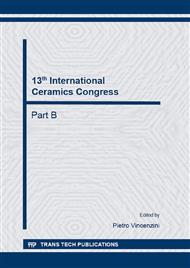[1]
B. Riccardi, L. Giancarli, A. Hasegawa, Y. Katoh, A. Kohyama, R.H. Joines, L.L. Snead, Issues and advances in SiCf/SiC composites development for fusion reactors, J. Nucl. Mater., 329-333 (2004) 56-65.
DOI: 10.1016/j.jnucmat.2004.04.002
Google Scholar
[2]
R. W. Messler, Jr., Joining of Materials and Structures, Elsevier Butterworth-Heinemann, Massachusetts, (2004).
Google Scholar
[3]
A. Needleman, An analysis of decohension along an imperfect interface, Int. J. Fracture, 42 (1990) 21-40.
Google Scholar
[4]
H. Serizawa, H. Murakawa, C.A. Lewinsohn, Modeling of Fracture Strength of SiC/SiC Composite Joints by Using Interface Elements, Ceram. Trans., 144 (2002) 335-342.
DOI: 10.1002/9781118406014.ch30
Google Scholar
[5]
H. Murakawa, H. Serizawa, K. Miyamoto, I. Oda, Strength of Joint between Dissimilar Elastic Materials, Proc. 2003 Int. Conf. Computational & Experimental Engineering & Sciences (ICCES'03), 6 (2003) CD-ROM.
Google Scholar
[6]
H. Serizawa, C.A. Lewinsohn, H. Murakawa, Development of new interface potential for evaluating strength of SiC/SiC composite joint, J. Nucl. Mater., 329-333 (2004) 492-496.
DOI: 10.1016/j.jnucmat.2004.04.108
Google Scholar
[7]
H. Serizawa, C.A. Lewinsohn, M. Singh, H. Murakawa, Evaluation of Fracture Behavior of Ceramic Composite Joints by Using a New Interface Potential, Mater. Sci. Forum, 502 (2005) 69-74.
DOI: 10.4028/www.scientific.net/msf.502.69
Google Scholar
[8]
H. Serizawa, C.A. Lewinsohn, M. Singh, H. Murakawa, Numerical Analysis of Test Methods for Evaluating Shear Strength of Ceramic Composite Joints Using Interface Element, Mater. Sci. Forum, 539-543 (2007) 2143-2148.
DOI: 10.4028/www.scientific.net/msf.539-543.2143
Google Scholar
[9]
H. Serizawa, T. Shibayama, H. Murakawa, Effect of Specimen Geometry on Microstructural Fracture Behavior in Nano Composites under HVEM, Ceram. Eng. and Sci. Proc., 35 (2014), to be published.
DOI: 10.1002/9781119031192.ch6
Google Scholar
[10]
M. Singh, Design, Fabrication and Characterization of High Temperature Joints in Ceramics Composites, Key Eng. Mater., 164-165 (1999) 415-420.
DOI: 10.4028/www.scientific.net/kem.164-165.415
Google Scholar
[11]
C.A. Lewinsohn, M. Singh, T. Shibayama, T. Hinoki, M. Ando, Y. Katoh, A. Kohyama, Joining of silicon carbide composites for fusion energy applications, J. Nucl. Mater., 283-287 (2000) 1258-1261.
DOI: 10.1016/s0022-3115(00)00247-6
Google Scholar
[12]
M. Singh and E. Lara-Curzio, Design, Fabrication, and Testing of Ceramic Joints for High Temperature SiC/SiC Composites, Proc. ASME TURBOEXPO 2000 (2000) 69-74.
DOI: 10.1115/2000-gt-0069
Google Scholar
[13]
T. Shibayama, T. Ogitsu, S. Yatsu, S. Watanabe, In-situ Observation of Crack Propagation in SiC/SiC by HVEM, Abstract of 13rd Int. Conf. Fus. Reactor Mater., (2007) 3115.
Google Scholar
[14]
T. Shibayama, G. Matsuo, K. Hamada, S. Watanabe, H. Kishimoto, In-situ Observation of Fracture Behavior on Nano Structure in NITE SiC/SiC Composite by HVEM, IOP Conf. Series: Mater. Sci. and Eng., 18 (2011) 162013.
DOI: 10.1088/1757-899x/18/16/162013
Google Scholar
[15]
H. Serizawa, T. Shibayama, H. Murakawa, Numerical Analysis of Microstructural Fracture Behavior in Nano Composites under HVEM, Ceram. Eng. and Sci. Proc., 34 (2013) 151-159.
DOI: 10.1002/9781118807965.ch18
Google Scholar
[16]
J. Lubliner, Plasticity Theory, Pearson Education Inc., New Jersey, (2006).
Google Scholar


